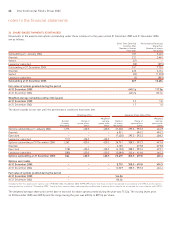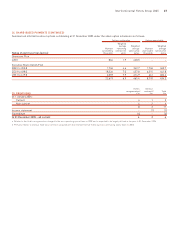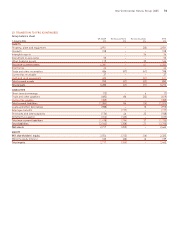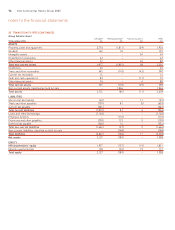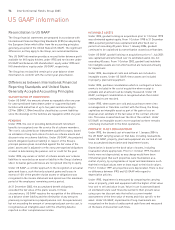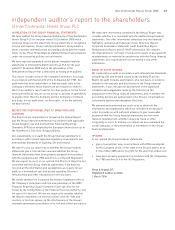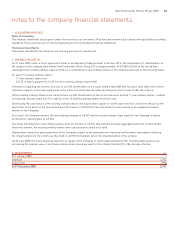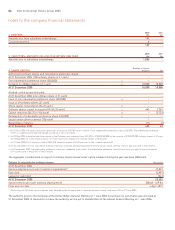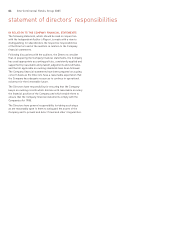Holiday Inn 2005 Annual Report Download - page 78
Download and view the complete annual report
Please find page 78 of the 2005 Holiday Inn annual report below. You can navigate through the pages in the report by either clicking on the pages listed below, or by using the keyword search tool below to find specific information within the annual report.
Reconciliation to US GAAP
The Group financial statements are prepared in accordance with
International Financial Reporting Standards (IFRS) as adopted by
the European Union which differ from the accounting principles
generally accepted in the United States (US GAAP). The significant
differences, as they apply to the Group, are summarised below.
This US GAAP information provides a reconciliation between profit
available for IHG equity holders under IFRS and net income under
US GAAP and between IHG shareholders’ equity under IFRS and
IHG shareholders’ equity under US GAAP, respectively.
The Group has reclassified certain prior year balance sheet
information to conform with the current year presentation.
Differences between International Financial
Reporting Standards and United States
Generally Accepted Accounting Principles
CLASSIFICATION OF BORROWINGS
Under US GAAP, the amounts shown as repayable after one year
for unsecured bank loans drawn under or supported by bank
facilities with maturities of up to five years and amounting to
£374m (2004 £1,104m) would be classified as current liabilities
since the drawings on the facilities are repayable within one year.
PENSIONS
Under IFRS, the cost of providing defined benefit retirement
benefits is recognised over the service life of scheme members.
The cost is calculated by an independent qualified actuary, based
on estimates of long-term rates of return on scheme assets and
discount rates on scheme liabilities. Under US GAAP, the projected
benefit obligation (pension liability) in respect of the Group’s
principal pension plans is matched against the fair value of the
plans’ assets and is adjusted to reflect any unrecognised obligations
or asset in determining the pension cost or credit for the year.
Under IFRS, any excess or deficit of scheme assets over scheme
liabilities is recorded as an asset or liability in the Group’s balance
sheet. Actuarial gains and losses are recognised directly in equity.
Under US GAAP, a corridor approach to the recognition of actuarial
gains and losses, such that only actuarial gains and losses in
excess of 10% of the greater of plan assets or obligations was
recognised in the income statement and spread over the maximum
period of the employees’ remaining service period.
At 31 December 2005, the accumulated benefit obligations
exceeded the fair value of the plans’ assets. In these
circumstances, US GAAP requires the recognition of the difference
as a balance sheet liability and the elimination of any amounts
previously recognised as a prepaid pension cost. An equal amount,
but not exceeding the amount of unrecognised past service cost, is
recognised as an intangible asset with the offsetting balance
reported in other comprehensive income.
INTANGIBLE ASSETS
Under IFRS, goodwill arising on acquisitions prior to 1 October 1998
was eliminated against equity. From 1 October 1998 to 31 December
2003, acquired goodwill was capitalised and amortised over a
period not exceeding 20 years. Since 1 January 2004, goodwill
continued to be capitalised but amortisation ceased as at that date.
Under US GAAP, goodwill arising on acquisitions prior to 1 July 2001
was capitalised and amortised over its estimated useful life, not
exceeding 40 years. From 1 October 2002, goodwill and indefinite
life intangible assets are not amortised but are reviewed annually
for impairment.
Under IFRS, development costs and software are included in
intangible assets. Under US GAAP, these assets are included
in property, plant and equipment.
Under IFRS, purchase consideration which is contingent on future
events is included in the cost of acquisition when receipt is
probable and an amount can be reliably measured. Under US
GAAP, contingent consideration is recognised when the related
contingencies are resolved.
Under IFRS, when assets are sold and a purchaser enters into
a management or franchise contract with the Group, the Group
capitalises an intangible asset as part of the gain or loss on
disposal at an estimate of the fair value of the contract entered
into. This value is amortised over the life of the contract. Under
US GAAP, an intangible asset is not recognised as there remains
continuing involvement in the hotel operations.
PROPERTY, PLANT AND EQUIPMENT
Under IFRS, the deemed cost at transition at 1 January 2004 is
the UK GAAP carrying values on that date, including revaluations.
Under US GAAP, property, plant and equipment are carried at cost
less accumulated depreciation and impairment losses.
Depreciation is based on the book value of assets, including
revaluation where appropriate. Prior to 1 October 1999, freehold
hotels were not depreciated, as any charge would have been
immaterial given that such properties were maintained, as a
matter of policy, by a programme of repair and maintenance such
that their residual values were at least equal to their book values.
From 1 October 1999, all properties were depreciated. There is now
no difference between IFRS and US GAAP with regard to
depreciation policies.
Under IFRS, impairment is measured by comparing the carrying
value of property, plant and equipment with the higher of fair value
less cost to sell and value in use. Value in use is assessed based
on estimated future cash flows discounted to their present value
using a pre-tax discount rate that reflects current market
assessments of the time value of money and risks specific to the
asset. Under US GAAP, impairments of long-lived assets are
recognised on the basis of undiscounted cash flows and measured
on the basis of discounted cash flows.
US GAAP information
76 InterContinental Hotels Group 2005


